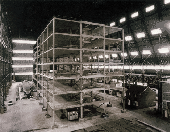
engineering & technology publications
ISSN 1759-3433
PROCEEDINGS OF THE SEVENTH INTERNATIONAL CONFERENCE ON COMPUTATIONAL STRUCTURES TECHNOLOGY
The Dynamic Characteristics of a Concrete Building from Construction to Completion
Manchester Centre for Civil and Construction Engineering, University of Manchester Institute of Science and Technology, United Kingdom
This study aims
- Examine the accuracy of the numerical models of the Cardington Concrete Building at different construction stages against the available frequency measurements.
- Identify quantitatively the efficiency of the bracing systems used in the building in terms of increased lateral stiffness.
- Check the validity of the relationship between the modal stiffness and static stiffness of the building.
The building consists of seven storeys of 3.75 m each in height, giving a total height of 26.25 m. The building has three bays of 7.50 m constituting a width of 22.50 m and four bays of 7.50 m making a length of 30.00 m. The building is shown in Figure 1.
The frequencies from the numerical modelling and measurements are compared for the seven construction stages.
The main findings from this study are
- The finite element models used in the paper give good representations of the building at different construction stages as the 31 predicted natural frequencies are close to these measured from experiments. Therefore the models can be used to investigate other related matters, such as the efficiency of the bracing systems and the stiffness of the building.
- The bracing systems used in the building can effectively increase the lateral stiffness of the building. The lateral stiffness of the building increases between 75% and 150% due to the use of the conventional bracing system. If the bracing pattern is altered to a global bracing system, the lateral stiffness of the building will be further increased without using extra materials.
- The relationship between the modal stiffness and static stiffness of a structure is assessed using the real structure. As the building is three dimensional, it provides an opportunity to examine the calculation of the modal mass of a real structure. The comparison of the two stiffnesses at the three selected stages shows that the newly derived relationship holds.
- 1
- Bougard, A.J., Ellis, B.R., "Vibrating testing of the Cardington Framed Building", The 3rd Cardington Conference, 26-27 November, Bedfordshire, UK, 1998.
purchase the full-text of this paper (price £20)
go to the previous paper
go to the next paper
return to the table of contents
return to the book description
purchase this book (price £135 +P&P)
